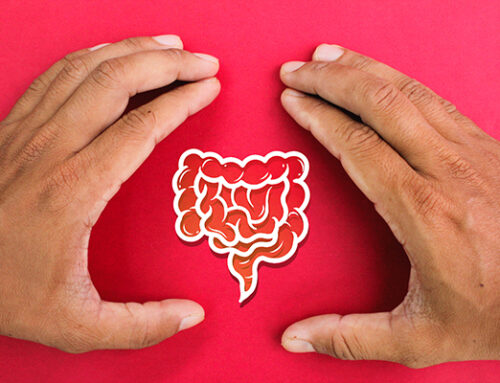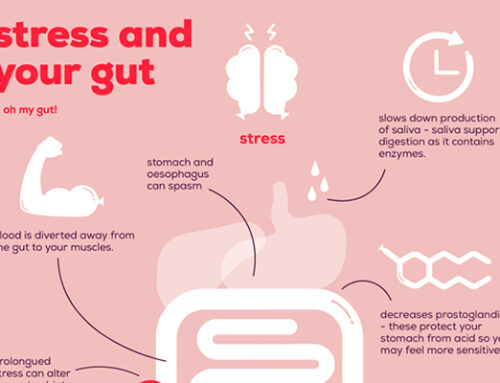 Myth #1 –Yogurt and Kefir are effective probiotics.
Myth #1 –Yogurt and Kefir are effective probiotics.
Yogurt and Kefir are considered ‘functional fermented foods’ and while they may contain ‘live and active cultures’ it is usually in very low doses, too low to have any therapeutic effect. (1) In addition, they are often pasteurized (which kills probiotics) and lack any protective delivery system to help them survive transit through our harsh acidic stomach to reach the small and large intestine where they are most active. (1) (2) (3)
Also, most yogurts and kefir are filled with sugar, preservatives and all kinds of things that aren’t good for you. To give you an example, an average six ounce serving of yogurt contains 22 grams of sugar and 157 calories, with some yogurts as high 36 grams of sugar and 260 calories per serving! To get the same quantity of probiotic bacteria found in one convenient probiotic capsule (30 billion cfu) you would have to consume 27 servings of yogurt; that’s 4,239+ calories and 594 grams of sugar! (4) (5) (6)
We’re not saying, don’t eat yogurt or throw away your sauerkraut, we enjoy these too and believe they are great additions to a healthy diet, but realize that the amount of probiotic received is minimal and not likely to have any major impact on your overall gut health.
Myth #2 – Pills Are Better Than Liquid.
FACT. The
Myth #3 – Multi-strain probiotics are better than targeted single strain probiotics.
Now, this is a tough one, because multi-strain probiotics manufactured such that each strain is separated, identified and validated are an excellent choice, but virtually all multi-strain probiotics are not made this way, so be careful when you select these and let me explain why. By their very nature all bacteria are antagonistic – meaning they don’t play well together. (7) In fact, one of the reasons probiotics are effective is because they displace potentially harmful bacteria in our gut with beneficial bacteria. Now, think about that statement… they work by displacing one another. Can you imagine what takes place when you put 4 or 5 or 10+ strains into one supplement? You guessed it, they destroy each other.
This is what we call the “closed-ended system” problem – when you place a live product into a closed-ended system such as a capsule/bottle you limit available resources (ie. oxygen, food) and the bacteria fight to use up the resources until they are depleted, once the resources are gone the bacteria begin to die. We can prevent some of this through freeze drying, which arrests bacterial growth, but since we are trying to maintain a live organism some competition will continue. Read the label of multi-strain probiotics carefully and ensure that each individual probiotic strain is micro-enrobed to maintain them in separate non-competitive environments within the supplement.
If you attempt to cram too many probiotic strains into one supplement you run into a very real space issue. How can you possibly fit an effective dose of 7 or 10 probiotics strains into one capsule? Chances are the cfus are approaching very low non-therapeutic levels. Make sure a cfu is given for each individual strain listed, as opposed to just a sum total for the mixture, otherwise you really have no idea what you are taking and if the levels are effective. A general rule of thumb is to stick to a product with 1 to 3 strains at most.
In addition, it doesn’t make sense to combine five strains that are all active in the small intestine as they will end up competing with one another. Instead, look for a mixture that combines strains with varying active sites in the GI tract (ie. small vs. large intestine), thereby caring for your whole GI tract.
The reality is a HUGE segment of probiotics on the market today are contract manufactured by one company with a marketing position. Look for companies that genuinely care about your health, companies that continue to research and explore the science of probiotics on a regular basis and companies who are the actual manufacture of their product.
Myth #4 – All probiotic species and strains are the same.
FALSE. That’s like saying you and I are one and the same. We are both homo sapiens sapiens after all so we can’t be that different, right? Wrong. I have only just met you, but something tells me we are not the same.
Let me explain the scientific jargon here … take for example the most commonly referred to probiotic Lactobacillus acidophilus, Lactobacillus identifies the probiotic at the genus level. Add on acidophilus and you have now identified the species level. But what comes next? This is where common names come in, my name is Julie your name is ____? It’s the same with probiotics but instead of a common name we have STRAIN names. For example, Natren uses Lactobacillus acidophilus, NAS strain. And just like you and I are different, every strain of L. acidophilus is different.
Many manufacturing companies do not distinguish the strains; they wrongfully assume that all L. acidophilus strains are the same. In fact, each strain can have varying probiotic benefits and strengths. (8) For example, not all L. acidophilus strains adhere well in the GI tract, without this important characteristic they tend to wash right through our bodies, in one end and out the other. Look for a quality product that identifies genus (ex. Lactobacillus), species (ex. acidophilus) and strain (ex. NAS); all together it looks like this: Lactobacillus acidophilus, NAS.
Myth #5 – Enteric coatings provide sufficient protection for probiotics.
FALSE. The difficult part about working with these delicate living organisms is delivering them safely to the part of our GI tract where they naturally exist, the small and large intestine. That stomach gets in the way every time, the low acidity in the stomach was designed to keep bacteria out! So protection, to help bacteria survive through the stomach, is important, but enteric coatings are the wrong way to go for one main reason – they retain moisture! (9) All probiotics are freeze-dried (unless the product is fresh as in yogurt); freeze drying temporarily arrests the growth of the bacteria and eliminates moisture. So what reactivates their growth? You guessed it, moisture! If the enteric coating process adds moisture back into the product the bacteria begin to grow and compete with one another for resources, eventually they run out of resources within the capsule or bottle and die quickly.
So how can you properly protect probiotics? The answer actually has numerous parts; you start by selecting well-studied strains (see Myth #4) that are known to be hardy, coupled with a manufacturing process that includes the supernatant. (10) (11) During the manufacturing process bacteria are grown on a specialized food or growth medium, after fermentation occurs this is referred to as the supernatant or fermentation end product. Typically, the supernatant is separated from the bacteria prior to freeze drying, but there are valuable byproducts with in the supernatant. Probiotics that go through a full culture process to maintain this intrinsic supernatant in the final product are adding an additional layer of protection to the product as it naturally shields the bacteria from stomach acid. The supernatant also adds additional benefits to the probiotic user in the form of micronutrients.
The next step is the addition of an oil matrix system that microenrobe the bacteria. The oil is a fat and not digested by the stomach but rather emulsified by bile in the upper GI tract, releasing the bacteria to colonize and grow where they are most beneficial. And finally, you have protective packaging; look for supplements that are further protected in hard gel capsules and stored in dark glass bottles. The dark bottles are resistant to UV damage and the glass is impermeable to moisture than plastic. Whereas, plastic is highly permeable and not as eco-friendly as glass.
Myth #6 – Homeostatic soil organisms and spore-forming bacteria are safe and effective probiotics.
FALSE and this one makes me cringe a little bit. Okay maybe a lot. The whole point of probiotic supplementation is to help restore the balance in your digestive system. How do we do this? By supplying the GI tract with probiotic bacterial species that normally colonize the human GI tract. How can you expect to balance this system by ingesting bacteria that are not normally found here? And why would you want to put soil bacteria in your body? Several companies in the USA use soil borne bacteria such as the genus Bacillus in probiotic products because they are stable since they produce spores. (12) Spores can survive extremes such as heating, freezing, drying and radiation– so refrigerated storage is not required (12). This is quite convenient for the manufacture that no longer has to worry about producing, storing and shipping a cold product. But, we are left to wonder if this is a safe practice? Also, if a spore is an inactive vegetative state of bacteria how do we know if it ever becomes active inside our body? Astoundingly, one company that uses this bacteria has published a study showing that less than 10% of their spores germinated into an active (and therefore useful) form! (13) There is additional concern that these organisms may be able to enter the blood stream in people with depressed immune systems and cause septicemia. (14) There are so many well studied, clinically trialed probiotic strains, which are naturally occurring human flora that there is simply no need to mess around with soil bacteria. I would stay far away from these until these questions have been thoroughly studied by the scientific community. The benefit here is solely to the manufacturer.
Myth #7 – Probiotics do not need to be refrigerated or shipped in thermally controlled packaging.
Get out?! You mean you can put a live organism in a capsule, stick it in the back of a hot truck, ship it across the country, place it on a shelf and leave it there for awhile and it will still be alive? Gosh, I’m not even sure if I would survive that! I think NOT. This is a big FALSE. The truth is, without continuous temperature control probiotics will die. I challenge you to read the label here – if the probiotic does not require refrigeration chances are you are selecting soil spore forming non-human bacteria strains (see Myth #6 above) or the product guarantees potency at the time of manufacture or maybe they don’t guarantee their potency at all? All of these should be red flags. Look for products in the refrigerated section, which guarantee potency through the EXPIRATION DATE of each species and strain, and do not contain spore-forming soil based bacteria.
Myth #8 – Adding prebiotics like Fructo-oligosaccharides (FOS) to probiotics is beneficial.
FALSE. Prebiotics are designed to provide the beneficial bacteria in your GI tract with a food substance that encourages their growth. However, when you take a prebiotic you have no control over which bacteria are benefiting and proliferating because of it. Therefore, you may be feeding the bad bacteria along with the good bacteria. (15) Scientific evidence has shown that by taking a prebiotic we are also encouraging yeast growth and the growth of potentially harmful bacteria such as Klebsiella, E. coli, and Salmonella. (15) (16) (17) In addition, studies have shown that FOS actually impairs the intestinal barrier (this is exactly what we are trying to prevent by taking probiotics in the first place). (18) And you might be shocked to know that the list of side effects associated with FOS includes diarrhea, abdominal rumbling, bloating, cramping and excessive flatulence. (19) Many people take probiotics to help with digestive upsets, so why would they want to add on a prebiotic with known side effects like this? Probiotics that include the Intrinsic Supernatant (aka Growth Medium) are carrying their own food source with them so there is no need to combine them with additional prebiotics.
Myth #9 – You shouldn’t take probiotics when you are taking prescription antibiotics.
This is a big false! It is even more important to take probiotics while you are taking antibiotics. Antibiotics are very potent, and kill not only the bad bacteria in your body that are causing an infection, but kill the good bacteria as well. This may be why antibiotics are often associated with nasty gastrointestinal symptoms such as diarrhea. In fact, taking probiotics has been shown to reduce the incidence of antibiotic associated diarrhea by 42%! (20)
In order to allow both antibiotics and probiotics to work in your GI tract simply separate the times that you take them by at least a few hours. Take your antibiotics, then 2 hours later take your probiotics.
Myth #10 – You do NOT need to take a probiotic everyday.
Probiotics can only benefit you if you take them. You might think that if you aren’t actively doing something to damage your gut flora, such as taking antibiotics, that you don’t need a probiotic supplement. This is wrong. There are many reasons why you may have an unbalanced and unhealthy gut flora. For example, excessive hygiene precautions and chlorinated drinking water; many drinking water sources contain anti-microbial agents such as chlorine that kill the good bacteria in our bodies. (21) In addition, an unvaried diet and stress can lead to an off-balance system. (22) Speaking of diet, every time you eat you are introducing bacteria into your GI tract that may or may not be harmful, balancing this with beneficial probiotic bacteria is always a good idea. By supplementing with a high quality probiotic you can off-set these problems and set your body on the right path to health every day.
Myth #11 – Diet does not play a role in probiotic effectiveness.
This is false. Diet is just as important to bacteria as it is to humans. Studies have shown that the composition of our gut microbiota changes in response to the diet we eat. (22) An unbalanced, unvaried diet contributes to a less diverse makeup of bacteria in our gut. Scientists hypothesize that decreased microbial exposure through diet and other means are the cause of numerous health problems today. (22) It is important to enjoy a varied diet to benefit your health as well as the health of your bacteria.
Myth #12 – Enterococcus faecalis and Enterococcus faecium are safe probiotics.
FALSE. In fact, in Australia these two organisms are banned from use as probiotics because, “…significant safety concerns exist.” (23) E. faecalis has been known to cause infections in humans, such as bladder infections. (24) (25) It has also been studied and noted that it is able to transmit antibiotic resistance through plasmid transfer, which is a very unsafe characteristic. (24)
E. faecium is becoming more and more resistant to antibiotics, which is a dangerous thing. (26) Organisms such as Lactobacillus acidophilus, Bifidobacterium bifidum, Bifidobacterium infantis and Lactobacillus bulgaricus are heavily researched and well accepted in the probiotic community. (6)
However, animals require stronger probiotic strains since they are exposed to more undesirable bacteria than human beings. A special strain of E. faecium (NCIMB 10415 strain) has a proven track record in animal probiotic formulations. This particular strain has been tested and used extensively by a distinguished German veterinary doctor for decades and shown to lack the genes typically found in those strains that may cause infections. (27) Studies also show that this strain is not antibiotic resistant, and it’s been safely used in Europe for animals for well over 30 years. (27)
Myth #13 – Digestive enzymes mix well with probiotics.
Digestive enzyme makers would have you believe this to be the case. Digestive enzymes are found naturally in our saliva and stomach acid, in enzyme-rich foods and also provided in supplements. They work to break down food molecules into smaller pieces that our bodies can absorb. Unfortunately, digestive enzymes can also break down probiotics. Digestive enzymes should not be taken at the same time as probiotics.
References
1. Symposium: Probiotic Bacteria, Probiotic Bacteria: Selective Enumeration and Survival in Dairy Foods. Shah, N. P. 4, Melbourne : Journal of Dairy Science, 2000, Vol. 83. PMID: 10791807.
2. Lactose malabsorption from yogurt, pasteurized yogurt, sweet acidophilus milk, and cultured milk in lactase-deficient individuals. Savaiano, Dennis A., et al. 6, St. Paul : The American Journal of Clinical Nutrition, 1984, Vol. 40. PMID: 6439026.
3. Survival of Lactobacillus acidophilus and Bifidobacterium bifidum in Commercial Yoghurt During Refrigerated Storage. Melbourne : International Dairy Journal, 1995, Vol. 5.
4. PopSugar. Yogurt Breakdown. [Online] PopSugar, March 18, 2008. [Cited: July 8, 2014.] http://www.fitsugar.com/Nutritional-Breakdown-Popular-Yogurts-1122382.
5. Calculations on File Based on a Popular Yogurt Brand’s Data.
6. Expert consensus document: The International Scientific Association for Probiotics and Prebiotics consensus statement on the scope and appropriate use of the term probiotic. International Scientific Association for Probiotics and Prebiotics. Centennial : Nature reviews. Gastroenterology & hepatology., 2014, Vol. Epub ahead of print. PMID: 24912386.
7. “In vitro evaluation of single- and multi-strain-strain probiotics: Inter-strain inhibition between probiotic strains, and inhibition of pathogens. Chapman, C.M.C., Gibson, G. R. and Rowland, I. Reading : Anaerobe, 2012, Vol. 10. PMID: 22677262.
8. Factors to Consider When Selecting a Culture of Lactobacillus acidophilus as a Dietary adjunct to produce a hypocholesterolemic effect in humans. Gilliland, S. E. and Walker, D. K. Stillwater : Journal of Dairy Science, 1990, Vol. 73. PMID: 2111831.
9. Hermelin, Victor M. Enteric Coated Tablets and Methods of Making the Same. 2,714,084 USA, July 26, 1955. Grant.
10. Quality assurance for probiotic bacteria. Elina Tuomola, Ross Crittenden, Martin Playne, Erika Isolauri, and Seppo Salminen. Turku : American Journal of Clinical Nutrition, 2001, Vol. 73(suppl).
11. Quantitative profiling of bacteriocins present in dairy-free probiotic preparations of Lactobacillus acidophilus by nanoliquid chromatography-tandem mass spectrometry. Nandakumar, Renu and Talapatra, Kesh. Lincoln : Journal of Dairy Science, 2013, Vol. 97. PMID: 24565320.
12. Sporeformers as Human Probiotics: Bacillus, Sporolactobacillus, and Brevibacillus. Sanders, M.E., Morelli, L. and Tompkins, T.A. s.l. : Comprehensive Reviews in Food Science and Food Safety, 2003, Vol. 2. doi: 10.1111.
13. Survival and metabolic activity of the GanedenBC30 strain of Bacillus coagulans in a dynamic in vitro model of the somach and small intestine. Maathuis, A.J.H., Keller, D. and Farmer, S. 1, Mayfield Heights : Beneficial Microbes, 2010, Vol. 1.
14. Recurrent Septicemia in an Immunocompromised Patient due to Probiotic Strains of Bacillus Subtilis. Oggioni MR, Pozzi G, Valensin PE, Galieni P, Bigazzi C. 1, Siena : Journal of Clinical Microbiology, 1998, Vol. 36. PMID: 9431982.
15. A genomic island of an extraintestinal pathogenic Escherichia coli Strain enables the metabolism of fructooligosaccharides, which improves intestinal colonization. Schouler C, Taki A, Chouikha I, Moulin-Schouleur M, Gilot P. 1, Nouzilly : Journal of Bacteriology, 2009, Vol. 191. PMID: 18978057.
16. Effects of Fructooligosaccharides on Intestinal Flora and Human Health. Hidaka, Hidemasa, Eida, Toshiaki and Takizawa, Toshio. 1, Kawasaki : Bifidobacteria Microflora, 1986, Vol. 5.
17. Some putative prebiotics increase the severity of Salmonella enterica serovar Typhimurium infection in mice. Petersen A, Heegaard PM, Pedersen AL, Andersen JB, Sørensen RB, Frøkiaer H, Lahtinen SJ, Ouwehand AC, Poulsen M, Licht TR.245, Soeborg : BioMed Central (BMC) microbiology, 2009, Vol. 9. PMID: 19948011.
18. Dietary fructooligosaccharides increase intestinal permeability in rats. Ten Bruggencate SJ, Bovee-Oudenhoven IM, Lettink-Wissink ML, Van der Meer R. Ede : The Journal of Nutrition, 2005, Vol. 135. PMID: 15795444.
19. Inulin-Type Prebiotics: A Review (Part 2). Kelly, Greg. 1, s.l. : Alternative Medicine Review, 2009, Vol. 14. PMID: 19364192 .
20. Probiotics for the prevention and treatment of antibiotic-associated diarrhea: a systematic review and meta-analysis. Hempel S, Newberry SJ, Maher AR, Wang Z, Miles JN, Shanman R, Johnsen B, Shekelle PG. 18, Santa Monica : Journal of the American Medical Association, 2012, Vol. 307. PMID: 22570464.
21. Prebiotics, faecal transplants and microbial network units to stimulate biodiversity of the human gut microbiome. Van den Abbeele P, Verstraete W, El Aidy S, Geirnaert A, Van de Wiele T. 4, Ghent : Microbial biotechnology, 2013, Vol. 6. PMID: 23594389.
22. Impact of diet in shaping gut microbiota revealed by a comparative study in children from Europe and rural Africa. De Filippo C, Cavalieri D, Di Paola M, Ramazzotti M, Poullet JB, Massart S, Collini S, Pieraccini G, Lionetti P. 33, Firenze : Proceedings of the National Academy of Sciences of the United States of America, 2010, Vol. 107. PMID: 20679230.
23. Australian Government Department of Health Therapeuitc Goods Administration. Item 3.2.2 Probiotic organisms Recommendation 6. [Online] Complementary Medicines Evaluation Committee, October 29, 1998. [Cited: July 10, 2014.] http://www.tga.gov.au/archive/committees-cmec-resolutions-09.htm#i322.
24. In vivo transfer of pAM beta 1 from Lactobacillus reuteri to Enterococcus faecalis. Morelli L, Sarra PG, Bottazzi V. 5, Piacenza : The Journal of applied bacteriology, 1988, Vol. 65. PMID: 2976754.
25. Study on pathogenesis of Enterococcus faecalis in urinary tract. Hirose T, Kumamoto Y, Tanaka N, Yoshioka M, Tsukamoto T. 2, s.l. : Urological research, 1989, Vol. 17. PMID: 2499973.
26. Frequent occurrence of multidrug-resistant CC17 Enterococcus faecium among clinical isolates in Sweden. Billström H, Top J, Edlund C, Lund B. 5, Stockholm : Journal of Applied Microbiology, 2010, Vol. 108. PMID: 19878525.
27. Scientific Opinion on the safety and efficacy of Enterococcus faecium (NCIMB 10415, DSM 22502, ATCC 53519 and ATCC 55593) as silage additives for all animal species. European Food Safety Authority (EFSA). 10, Parma : EFSA, 2013, Vol. 11.







